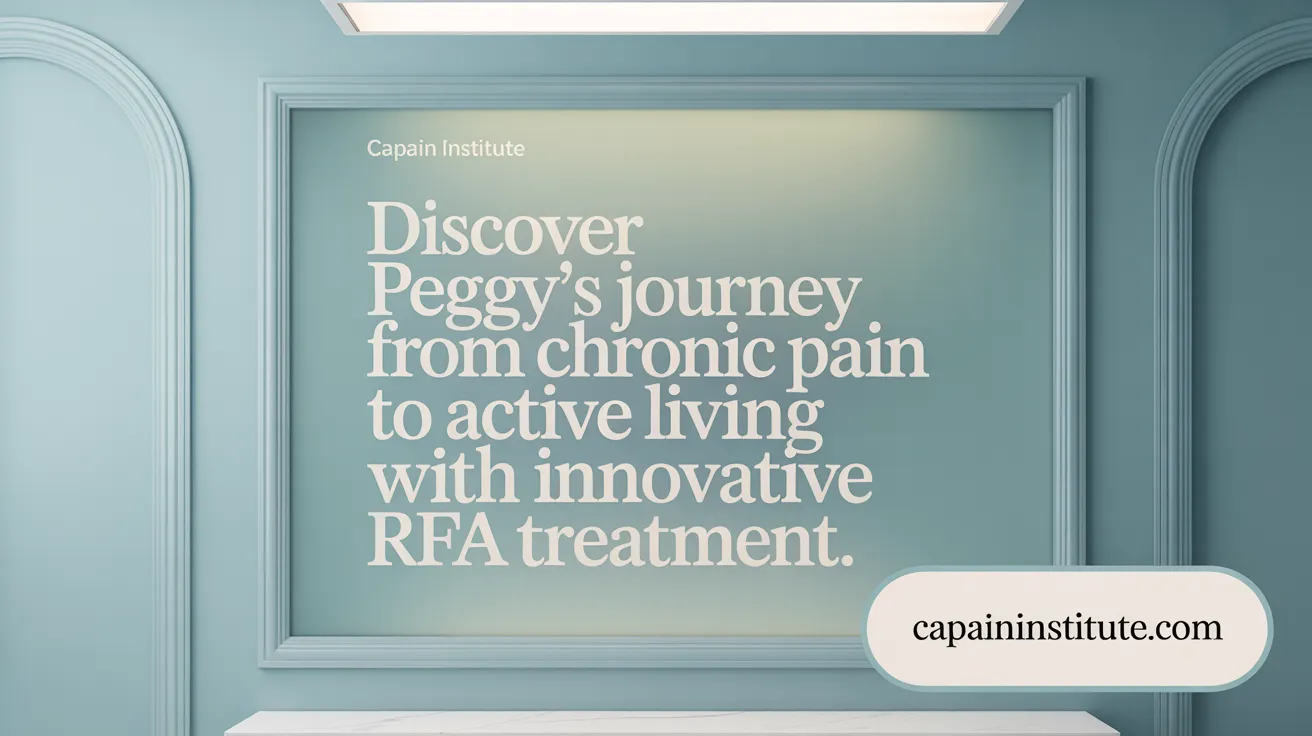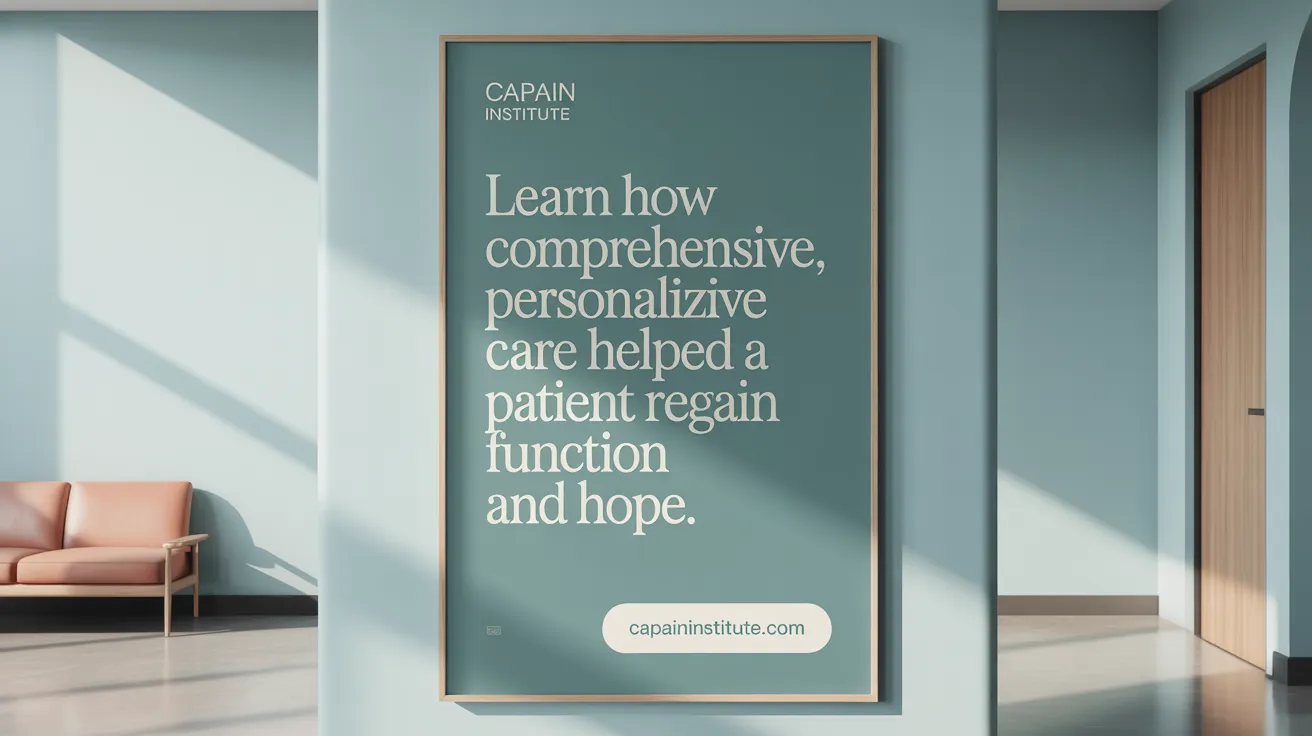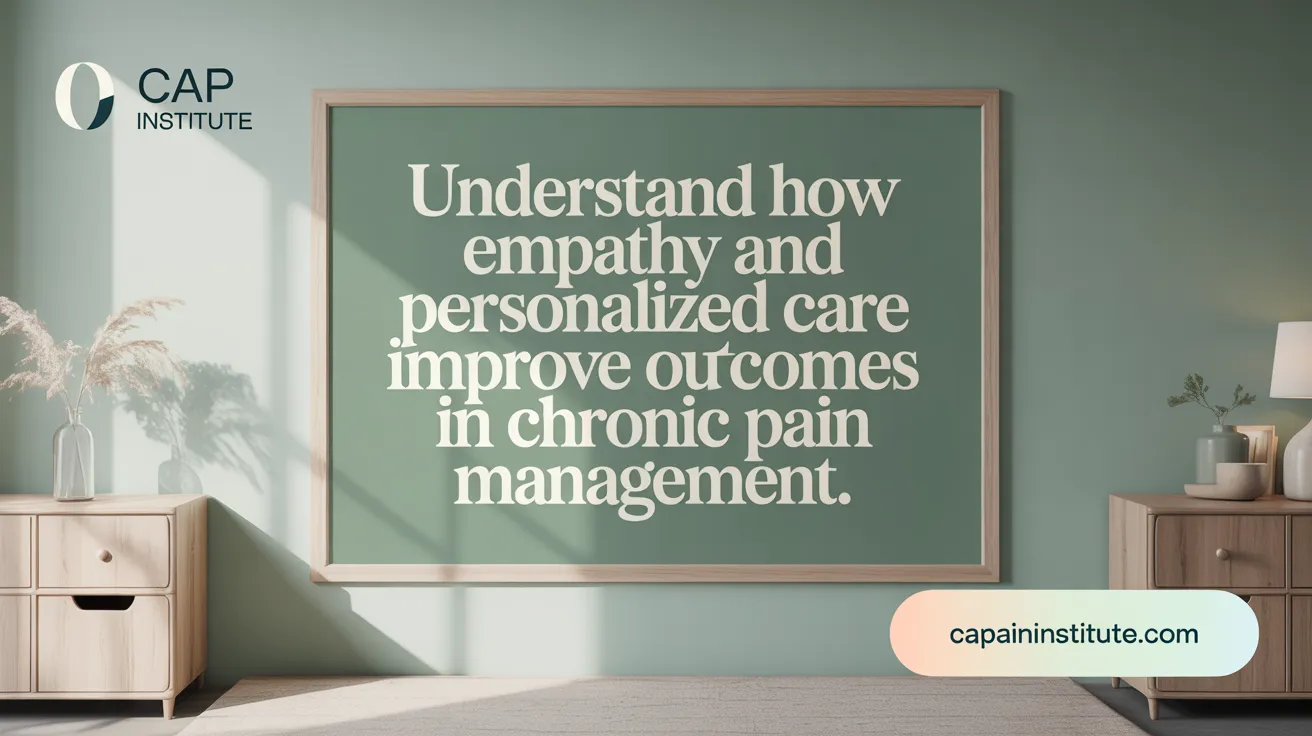Embracing Hope Through Personalized Pain Management
Chronic pain affects millions worldwide, often diminishing quality of life and daily functioning. However, inspiring patient stories reveal that with the right multidisciplinary approaches and innovative treatments, substantial relief and renewed vitality are possible. This article explores real-life successes, emphasizing the importance of individualized care, patient empowerment, and the evolving landscape of chronic pain management.
Peggy's Path to Pain Relief Through Radiofrequency Ablation

Patient Background and Initial Challenges
Peggy Guin, a retired nurse practitioner, faced severe osteoporosis compounded by chronic back pain following a car crash in July 2017 that resulted in a lower back fracture. Despite her medical knowledge in neurology and neurosurgery, she struggled with persistent, worsening pain.
Conservative Treatments Tried
Peggy initially tried various conservative approaches including medications, acupuncture and massage, physical therapy, chiropractic care, walking, yoga, and heat and ice therapy. None provided lasting relief, reflecting the challenge many patients face when treating complex chronic pain (Chronic Noncancer Pain Treatment).
Innovative Procedure: Radiofrequency Ablation
Upon seeking care at UF Health Pain Medicine, Dr. Rene Przkora conducted thorough assessments and identified the pain source linked to Peggy's facet joints. She underwent radiofrequency ablation (RFA), a minimally invasive technique where tiny needles with electrodes heat and 'stun' sensory nerves to reduce pain signals temporarily (Minimally invasive pain treatment).
Treatment Outcomes and Lifestyle Impact
Peggy had the RFA procedure twice, about a year apart, achieving approximately 80% pain reduction (80% pain relief success. Recovery was swift with no activity restrictions. Pain relief empowered her to return to daily activities including walking up to five miles, gardening, and caring for pets — significantly enhancing her quality of life (Active lifestyle after pain treatment.
Patient Empowerment and Specialized Care
Her medical background enabled active participation in decision-making, supported by UF Health’s patient-centered approach emphasizing personalized treatment plans and education. The specialized care center provided options beyond typical medication or surgery, offering minimally invasive interventions tailored to individual needs.
In sum, Peggy’s story highlights how combining expert personalized care with advanced procedures like radiofrequency ablation can provide meaningful relief and restore activity for chronic pain sufferers.
Megan's Multidisciplinary Approach: Movement as Medicine

How did Megan manage her chronic pain through a multidisciplinary program?
Megan H. faced multiple chronic health issues including scoliosis, degenerative disc disease, herniated discs, spinal stenosis, and dysautonomia conditions like migraines and severe irritable bowel syndrome. These complex conditions caused frequent and severe pain flare-ups that significantly reduced her quality of life.
At the Shirley Ryan AbilityLab Pain Management Center, Megan joined a multidisciplinary program that brought together medical doctors, psychologists, physical therapists, and occupational therapists. This team created a personalized treatment plan focused on active patient participation.
In physical therapy, Megan performed gentle stretching, nerve gliding, and specialized pelvic floor exercises to regain sensation and ease her pain. Occupational therapy helped her improve body mechanics, tolerance for standing and sitting, as well as pacing strategies. Activities such as chair yoga, tai chi, and water aerobics were introduced to enhance mobility.
A pain psychologist worked with Megan on relaxation and mindfulness techniques, essential tools that helped her cope emotionally with chronic pain. Additionally, participating in group sessions provided Megan with much-needed social support, helping reduce feelings of isolation and fostering hope.
After completing the program, Megan reported substantial improvements: she could manage flare-ups more effectively, resume activities like attending her children’s sports events and social outings, and experienced a positive shift in mindset. She described the experience as a 'reset' that empowered her to take control of her chronic pain and live a fuller life.
Comprehensive Care at HealthPartners: A Journey from CRPS to Recovery

What factors contributed to the successful pain management of a patient with CRPS?
Complex Regional Pain Syndrome (CRPS) can be a devastating chronic pain condition. One patient's journey at HealthPartners and Regions Hospital showcases the power of comprehensive, multidisciplinary care in managing CRPS.
The patient's pain originated from an old knee injury that evolved into CRPS. The care team comprised neurologists, plastic surgeons, mental health professionals, and physical therapists, highlighting the importance of diverse expertise.
Physical therapy played a critical role in improving mobility and function, despite the persistent pain. The patient also underwent multiple surgeries, including knee replacement and major spinal surgery for nerve degeneration.
A spinal cord stimulator was implanted to modulate pain signals, providing additional symptom relief. This advanced intervention contributed significantly to the patient's comfort.
Psychological support was essential, addressing depression and emotional challenges linked to chronic pain. The patient participated in a residential chronic pain rehabilitation program at the Courage Center, where she learned strategies to better manage her condition.
Even after setbacks such as hospitalizations and the emotional strain of chronic pain, the patient demonstrated remarkable resilience. Support from a compassionate healthcare team was vital in empowering her recovery.
Ultimately, these combined interventions and the dedicated care environment helped the patient regain function and return to a healthcare career, exemplifying the potential for positive outcomes in severe chronic pain cases.
Innovations in Pediatric Chronic Pain Management: Tracie’s Opioid-Free Recovery

What challenges exist in managing pediatric chronic pain?
Chronic pain in children and teenagers presents unique challenges, including the risk of opioid dependency from traditional pain treatments. Often, young patients experience pain from conditions like tumors or injuries that require careful, age-appropriate management. For more on pediatric pain management, see Tracie's story of opioid-free pain management.
How was opioid dependence addressed in pediatric chronic pain management?
Tracie, a 19-year-old with a non-cancerous brain tumor, faced opioid dependence due to her pain. The Chronic Pain Clinic at Johns Hopkins All Children’s Hospital implemented a multidisciplinary, non-narcotic treatment plan for her. This plan combined peripheral nerve blocks for pain, guided imagery for pain relief, music therapy in pain management, psychological support, and physical therapy.
What multidisciplinary approaches were used?
The team integrated multiple therapies to target both physical and emotional aspects of pain. Peripheral nerve blocks eased nerve pain, while guided imagery and music therapy helped reduce anxiety and improve coping. Psychological care focused on emotional support, and physical therapy promoted function without opioid use. This approach reflects best practices for multidisciplinary pediatric pain management.
How do nerve blocks and psychological therapies contribute?
Nerve blocks provide direct pain relief by interrupting nerve signals. Psychological therapies address the mental burden of chronic pain, reducing distress and enhancing resilience through relaxation and coping strategies. For further information on combining physical and psychological therapies for chronic pain, consider Megan's story.
What role does opioid dependency reduction play?
By utilizing non-narcotic therapies, the clinic successfully supported Tracie in becoming opioid-free. This reduced risks associated with opioid use, such as addiction and side effects, focusing instead on long-term health and function. This aligns with strategies recommended in CDC guidelines for pain management.
How did this approach improve quality of life?
Tracie's opioid-free management led to marked improvement in daily functioning and social participation. She regained normal activities and a better sense of well-being, demonstrating the effectiveness of comprehensive, non-opioid pediatric pain care. To explore more real patient impact stories on chronic pain management, see Boston Scientific's patient stories.
Patient Perspectives: The Vital Role of Empathy and Personalized Care

How does physician empathy influence outcomes in chronic pain treatment?
Research highlights that physician empathy plays a crucial role in improving outcomes for chronic pain patients. A comprehensive study involving 1,470 adults with chronic low back pain revealed that those treated by physicians with high empathy scores experienced markedly better outcomes. These included significant reductions in pain intensity, improvements in physical function, and enhanced health-related quality of life (Physician empathy and chronic pain).
The therapeutic relationship shaped by physician empathy encourages patients to feel genuinely heard and believed, which builds trust and increases their engagement in the treatment process. This emotional connection can have a greater positive effect on patient well-being than some medical interventions like opioid therapy or surgery (Chronic primary pain and patients' experiences).
Patient experiences of feeling heard and personalized pain management
Many patients with chronic pain report that feeling acknowledged and truly listened to by healthcare providers profoundly impacts their coping and satisfaction with care. Positive interactions where providers validate patient experiences foster hope and acceptance, which are critical in managing a long-term condition (patient experiences at pain management centre).
Personalized care approaches, where treatment plans are tailored to individual needs and circumstances, increase patient empowerment and adherence. Specialized pain management centers that emphasize detailed communication, explain various treatment options, and involve patients in decision-making contribute significantly to positive experiences and outcomes (Personalized pain treatment.
Supportive healthcare relationships and qualitative insights
Qualitative research from hospital-based pain management centers underscores the importance of empathetic staff and physicians who show understanding and compassion. Patients consistently recommend centers where they receive personalized care that goes beyond pain control and addresses overall quality of life (patient experiences at pain management centre.
Effective support includes clear information, ongoing encouragement, and recognition of the multidimensional nature of chronic pain — physical, emotional, and social. Such comprehensive support systems improve patient confidence and foster better long-term management success (Emotional Impact of Pain).
In summary, physician empathy and personalized care form the foundation of effective chronic pain management. These elements promote supportive healthcare relationships that enhance patient outcomes beyond the effects of specific medical treatments (Chronic Pain Management.
Alternative and Complementary Therapies: Empowering Patients Beyond Medication
What alternative therapies have proven effective in chronic pain management?
Alternative and complementary therapies have become essential options for many chronic pain sufferers seeking relief beyond traditional medications. Treatments such as acupuncture for chronic pain, massage therapy benefits, mindfulness-based strategies, and specific physical therapies like yoga and tai chi for pain have demonstrated benefits in managing chronic pain symptoms.
Acupuncture and massage therapy are notable for their ability to enhance circulation and soothe the nervous system. Acupuncture, with over 2,000 years of history, helps reduce pain related to neck pain, low back pain, osteoarthritis, fibromyalgia, and headaches. Massage therapy offers immediate relief for various musculoskeletal pains and, over time, can alleviate persistent conditions such as fibromyalgia.
Mindfulness and mind-body practices, including guided imagery, hypnosis, relaxation techniques, diaphragmatic breathing, and meditation, contribute to lowering pain intensity and reducing stress hormones, enhancing overall physical function (Pain Management Center at Shirley Ryan AbilityLab).
Yoga and tai chi combine controlled breathing, meditation, and gentle movement exercises. These have proven effective in easing arthritis, fibromyalgia, low-back and neck pain, improving joint flexibility, balance, and promoting mental well-being (Benefits of yoga and tai chi for pain).
Nutrition also plays a supportive role; diets rich in fruits, vegetables, whole grains, olive oil, and nuts—like the Mediterranean diet—may lessen pain severity. Supplements such as omega-3 fatty acids, vitamin D, and magnesium support joint function and reduce symptoms associated with chronic pain conditions like rheumatoid arthritis and fibromyalgia (Omega-3 fatty acids for chronic pain.
Crucially, effective pain management through these therapies involves personalized approaches tailored to each patient's unique condition and lifestyle. Collaborative communication between healthcare providers and patients ensures that complementary treatments are integrated safely and effectively, empowering patients to manage pain holistically and improve their quality of life (personalized pain treatment, Multidisciplinary approach in chronic pain.
Harnessing Patient Expectations and Digital Tools in Chronic Pain Recovery
How do patient expectations influence chronic pain treatment outcomes?
Patient expectations play a crucial role in determining the success of chronic pain management. Studies involving thousands of patients reveal that those who enter treatment with positive hopes for pain relief, improved quality of life, and better functioning tend to experience significantly greater improvements. These expectations directly impact key outcomes such as pain intensity, mood symptoms like depression, and overall physical function. The psychological aspect underscores the importance of addressing patients’ mindsets to enhance the effectiveness of pain therapies (Expectations Predict Chronic Pain Treatment Outcomes).
What role do digital self-management interventions play?
Healthcare providers increasingly recognize digital tools as promising adjuncts in chronic pain care. Digital self-management programs can deliver educational content, exercises, and motivational modules designed to enhance patients’ ability to manage pain daily. These interventions offer personalized support that is easily accessible and can complement face-to-face treatment, fostering behavior change and self-efficacy (Healthcare Providers' Experiences of Pain Management and Digital Interventions).
What challenges exist in adopting digital tools?
Despite enthusiasm about digital therapies, many healthcare providers have limited familiarity with such resources and seldom recommend them. Patients often face barriers including low motivation, literacy challenges, and limited technology access. Consequently, digital interventions must be designed with simple language, engaging content, and supportive reminders to maximize uptake and sustained use (Healthcare Providers' Experiences of Pain Management and Digital Interventions.
How can digital solutions integrate into clinical practice?
Successful integration requires collaboration between patients, clinicians, and technology developers. Digital tools should be tailored to fit seamlessly alongside physician care, potentially filling gaps where in-person resources are scarce or healthcare visits are brief. By incorporating user-friendly design and motivational features, these tools can improve pain management adherence and outcomes (Healthcare Providers' Experiences of Pain Management and Digital Interventions.
What are the future directions for pain management?
Moving forward, research and clinical practice will likely emphasize combining psychological insights with technology to optimize chronic pain treatment. Enhancing patient expectations through education, alongside accessible digital self-management interventions, offers a holistic approach. Addressing existing barriers will be critical to ensure these innovations benefit a broader patient population, improving quality of life for millions with chronic pain (Expectations Predict Chronic Pain Treatment Outcomes, Healthcare Providers' Experiences of Pain Management and Digital Interventions.
Real-Life Triumphs Illuminate Chronic Pain Treatment Advances
These diverse patient journeys underscore the transformative power of tailored, multidisciplinary approaches in chronic pain management. From innovative procedures like radiofrequency ablation to holistic therapies and psychological support, success hinges on patient engagement, empathetic care, and addressing the complex emotional and physical dimensions of pain. Embracing individual needs and fostering hope through personalized strategies not only alleviates suffering but restores agency and enriches lives. As research progresses and digital tools evolve, the stories of Peggy, Megan, and others inspire continued innovation and compassionate care, offering renewed optimism for millions navigating chronic pain.
